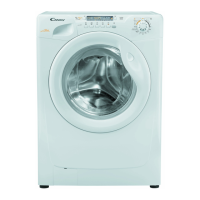
Do you have a question about the Candy GO W 485 D ALISE and is the answer not in the manual?
| Loading type | Front loading |
|---|---|
| Capacity | 8 kg |
| Spin Speed | 1400 RPM |
| Energy Efficiency Class | A |
| Dimensions (HxWxD) | 85 x 60 x 54 cm |
| Number of Programs | 15 |
| Noise Level (Wash) | 58 dB |
| Water Consumption | 60 L |
Details on finding model, number, and G number for contacting service.
List of items to check for inclusion with the machine upon delivery.
Instruction to check for damage incurred during transport.
Safety precautions for cleaning and maintenance, including plug and tap operations.
Guidelines on earthing, handling wet appliances, water temperature, and drum checks.
Precautions for appliance use, handling, and installation on carpet floors.
Steps for dealing with appliance failures and supply cord replacement.
Physical dimensions of the washing machine: height, width, and depth.
Key technical specifications including load capacity, power, and water levels.
Steps for removing transport screws, spacers, and preparing the machine.
Warning regarding the danger of packaging materials to children.
Guidance on water connections, outlet tube positioning, and installation restrictions.
Instructions for leveling the machine feet and final plug-in.
Identification of controls and display elements (A-P) on the machine's panel.
Explanation of the Kg Detector function and how to operate the door handle.
Details on using the programme selector, temperature, and spin speed buttons.
Explanation of the Degree of Soiling, Intensive, and Buttons Indicator lights.
Information on the Aquaplus button and the Delay Start function.
How to select drying programmes and important warnings.
Instructions for starting, pausing, and cancelling wash cycles.
Explanation of the Door Locked indicator light function.
Explanation of display indicators for wash temperature, door lock, and spin speed.
Information on delay start indicators and the display of cycle duration.
Explanation of indicators for Kg Detector, stain level, and drying programmes.
Tips for using timed drying programmes and cool down periods.
Details on programmes designed for resistant fabrics like cotton and linen.
Information on programmes for mixed fabrics and synthetics.
A programme alternating washing and soaking for delicate fabrics.
A special cycle for thoroughly washing wool garments without damage.
Details on Hand Wash, Rinse, and Fast Spin programmes.
Information on the Drain Only and the exclusive Mix & Wash programmes.
Overview of Rapid, Shirts, Synthetics, Cotton, and Rapid 59' programmes.
Identification of the three compartments for prewash, additives, and main wash detergent.
Notes on using a special dispenser and liquid products in compartments.
Advice against spinning heavy items like rugs and bedspreads.
Requirement for wool garments to have a 'Machine Washable Label'.
Precautions for sorting laundry, checking for metal, securing closures, and removing stains.
Tips for saving energy, water, and time by washing full loads.
Guidance on when pre-wash is needed to save resources.
Advice on reducing the need for hot washes and saving energy.
Tips on using high spin speeds before drying to save energy.
Explanation of how the machine adapts water level to load for energy saving.
Example of washing delicate fabrics and avoiding heavy loads.
Step-by-step guide for preparing and starting a wash cycle.
Handling power breaks and steps after programme completion.
Materials not suitable for drying and requirements for laundry.
Warnings on setting drying time, fabric fraying, and not opening during cool down.
Information on Cotton and Mixed fabric drying types.
Steps for selecting drying cycles and choosing timed drying options.
Warnings about the double-skin door and load restrictions for drying.
Instructions for starting the drying phase and completing the cycle.
Warning about the maximum load limit for satisfactory drying results.
Steps for the washing portion of the automatic cycle.
How to select the desired dryness level and timed drying.
Steps after the automatic wash/dry cycle finishes, including door unlock.
Instructions for cleaning the appliance exterior using a damp cloth.
Overview of essential maintenance tasks like drawer and filter cleaning.
Procedure for removing and cleaning the detergent drawer compartments.
Detailed steps for opening the flap, draining, and cleaning the filter.
Procedure for preparing the machine for long periods of storage.
Troubleshooting common issues like no function or failure to load water.
Resolving problems with water discharge and floor leakage.
Diagnosing and fixing issues related to spinning and strong vibrations.
Interpreting and resolving faults indicated by display error codes.
Handling persistent faults, contacting service, and effects of eco-detergents.
Essential checks to perform before contacting the Technical Assistance Service.